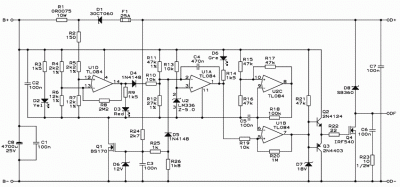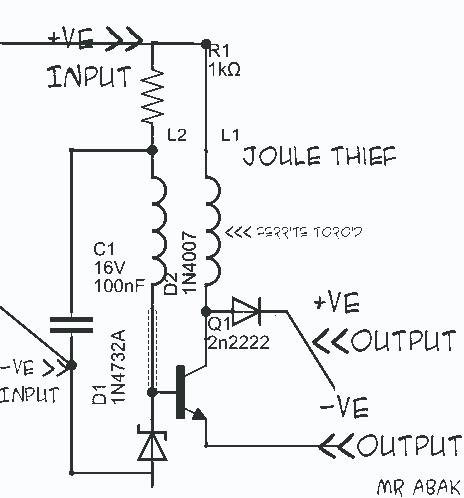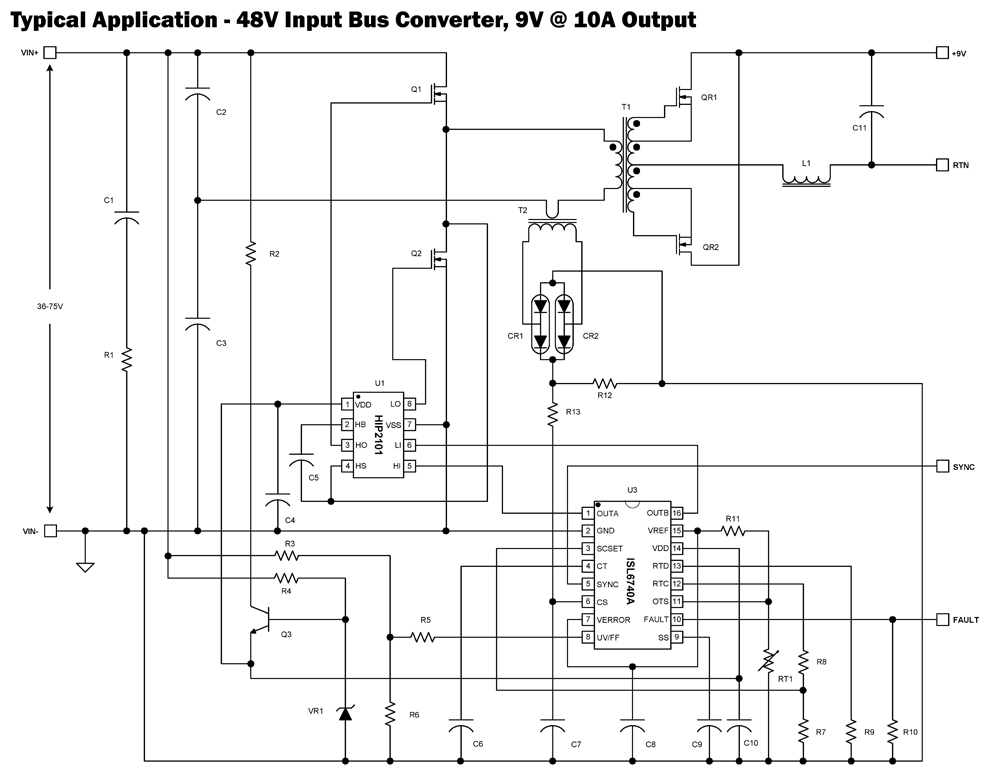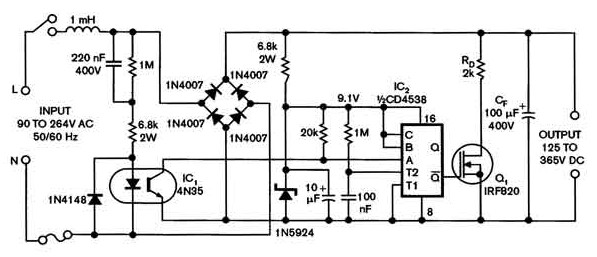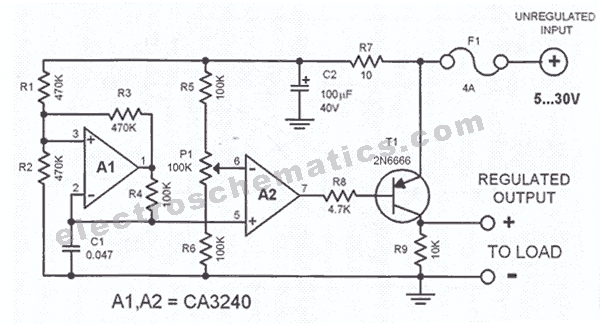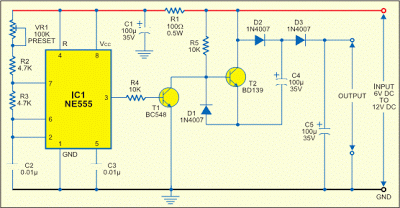
Efficient Negative Voltage Regulation

Many applications require highly efficient negative-voltage post regulators with low dropout voltage in switch-mode supplies. A method to achieve effective negative-voltage regulation is by utilizing a low-dropout positive-voltage regulator that operates from a well-isolated secondary winding of the switch-mode transformer. This technique is applicable to any positive-voltage regulator, although maximum efficiency is observed with low-dropout types. In the circuit, two programming resistors, R1 and R2, are used to set the output voltage to 12 V, while the LT1086 regulates the voltage between the output and its adjusting (ADJ) terminals to 1.25 V. Capacitor C1 enhances ripple rejection, and protection diode D1 mitigates common-load issues. Given that the secondary winding is galvanically isolated, the regulator's 12-V output can be referenced to ground. Consequently, for a negative-voltage output, the positive terminal of the regulator is connected to ground, and the -12-V output is derived from the anode of D1. The V-m terminal floats at 1.5 V or more above ground. This configuration is analogous to connecting the positive terminal of a battery to ground and extracting the output from the negative terminal.
The described circuit employs a low-dropout positive-voltage regulator to generate a stable negative voltage output, which is particularly advantageous in switch-mode power supplies. The use of a secondary winding from the transformer provides galvanic isolation, essential for safety and performance in various applications. The programming resistors R1 and R2 are critical for setting the desired output voltage to 12 V, allowing for flexibility in voltage regulation based on the specific requirements of the application.
The LT1086 regulator is a low-dropout type, which ensures that the output voltage remains stable even when the input voltage is only slightly higher than the output voltage. This characteristic is crucial for maintaining efficiency and minimizing power loss in the system. The voltage reference of 1.25 V between the output and the ADJ terminal is a standard feature of this regulator, providing a robust means of voltage regulation.
Capacitor C1 serves a dual purpose in the circuit. It not only improves ripple rejection, enhancing the overall stability of the output voltage, but also plays a role in filtering out high-frequency noise that may be present in the power supply. The inclusion of protection diode D1 is a smart design choice, as it helps to prevent common-load problems that can arise in shared power supply scenarios. By isolating the load from the regulator, it ensures that fluctuations in load do not adversely affect the voltage regulation.
The floating V-m terminal, positioned at 1.5 V or more above ground, provides additional flexibility in circuit design, allowing for integration with other components without risking ground loops or interference. This arrangement effectively simulates a battery configuration, where the positive terminal is grounded and the negative terminal serves as the output. This innovative approach to negative-voltage regulation is particularly beneficial in applications requiring precision and reliability, such as in analog circuits, sensor systems, and various digital applications. Many applications require highly efficient negative-voltage post regulators with low dropout voltage in switch-mode supplies. A way to provide good negative-voltage regulation is with a low-dropout positive-voltage regulator operating from a well-isolated secondary winding of the switch-mode transformer. The technique works with any positive-voltage regulator, although highest efficiency occurs with low-dropout types.
In the circuit, two programming resistors, Rl and R2, set the output voltage to 12 V, and the LT1086s servo the voltage between the output and its adjusting (ADJ) terminals to 1.25 V. Capacitor CI improves ripple rejection, and protection diode Dl eliminates common-load problems. Because a secondary winding is galvanically isolated, a regulator"s 12-V output can be referenced to ground.
Therefore, in the case of a negative-voltage output, the positive-voltage terminal of the regulator connects to ground, and the -12-V output comes off the anode of Dl. The V-m terminal floats at 1.5 V or more above ground. This arrangement is the equivalent of connecting the positive terminal of a battery to ground and taking the output from the negative terminal.
The described circuit employs a low-dropout positive-voltage regulator to generate a stable negative voltage output, which is particularly advantageous in switch-mode power supplies. The use of a secondary winding from the transformer provides galvanic isolation, essential for safety and performance in various applications. The programming resistors R1 and R2 are critical for setting the desired output voltage to 12 V, allowing for flexibility in voltage regulation based on the specific requirements of the application.
The LT1086 regulator is a low-dropout type, which ensures that the output voltage remains stable even when the input voltage is only slightly higher than the output voltage. This characteristic is crucial for maintaining efficiency and minimizing power loss in the system. The voltage reference of 1.25 V between the output and the ADJ terminal is a standard feature of this regulator, providing a robust means of voltage regulation.
Capacitor C1 serves a dual purpose in the circuit. It not only improves ripple rejection, enhancing the overall stability of the output voltage, but also plays a role in filtering out high-frequency noise that may be present in the power supply. The inclusion of protection diode D1 is a smart design choice, as it helps to prevent common-load problems that can arise in shared power supply scenarios. By isolating the load from the regulator, it ensures that fluctuations in load do not adversely affect the voltage regulation.
The floating V-m terminal, positioned at 1.5 V or more above ground, provides additional flexibility in circuit design, allowing for integration with other components without risking ground loops or interference. This arrangement effectively simulates a battery configuration, where the positive terminal is grounded and the negative terminal serves as the output. This innovative approach to negative-voltage regulation is particularly beneficial in applications requiring precision and reliability, such as in analog circuits, sensor systems, and various digital applications. Many applications require highly efficient negative-voltage post regulators with low dropout voltage in switch-mode supplies. A way to provide good negative-voltage regulation is with a low-dropout positive-voltage regulator operating from a well-isolated secondary winding of the switch-mode transformer. The technique works with any positive-voltage regulator, although highest efficiency occurs with low-dropout types.
In the circuit, two programming resistors, Rl and R2, set the output voltage to 12 V, and the LT1086s servo the voltage between the output and its adjusting (ADJ) terminals to 1.25 V. Capacitor CI improves ripple rejection, and protection diode Dl eliminates common-load problems. Because a secondary winding is galvanically isolated, a regulator"s 12-V output can be referenced to ground.
Therefore, in the case of a negative-voltage output, the positive-voltage terminal of the regulator connects to ground, and the -12-V output comes off the anode of Dl. The V-m terminal floats at 1.5 V or more above ground. This arrangement is the equivalent of connecting the positive terminal of a battery to ground and taking the output from the negative terminal.
